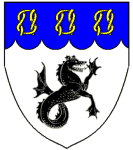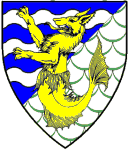| View previous topic :: View next topic |
| Author |
Message |
CAVU
Joined: 02 Nov 2003
Posts: 665
City/Region: Spokane
State or Province: WA
C-Dory Year: 2002
C-Dory Model: 22 Cruiser
Vessel Name: CAVU
Photos: CAVU
|
 Posted: Mon Mar 20, 2006 12:39 pm Post subject: Questions About Installing a New Chartplotter Posted: Mon Mar 20, 2006 12:39 pm Post subject: Questions About Installing a New Chartplotter |
 |
|
I am in the process of removing my old Lowrance LMS-240 and installing a new Lowrance LCX-26. The manual says I may get interference if I don't hook it up directly to the battery. The old one was powered off the buss behind the dash and worked fine as far as I could tell. Has anyone had problems with using power from the dash buss? I also noted in my 2002 C-Dory owners manual that the wiring diagram shows a #10AWG pos (red) wire to the buss, but a #8AWG grd (black) wire. Why would the ground wire be bigger? I also noticed that it is not marine wire. The crimped end at the buss is not tinned wire-looks like plain copper. Should I change this out while I have all the wire ties cut?
_________________
Ken Trease
22 CD Cruiser, CAVU
Twin 40HP Hondas |
|
| Back to top |
|
 |
Chris Bulovsky
Joined: 11 Mar 2004
Posts: 358
City/Region: Washburn
State or Province: WI
C-Dory Year: 1998
C-Dory Model: 22 Cruiser
Vessel Name: SCOUT
Photos: SCOUT
|
 Posted: Mon Mar 20, 2006 3:14 pm Post subject: Posted: Mon Mar 20, 2006 3:14 pm Post subject: |
 |
|
I read the same thing (LMS -332c) and wired it directly. Used a extension cord wire with fuses. Not sure if you will get interference, but I only wanted to wire it once so I followed the directions.
It works.
Chris |
|
| Back to top |
|
 |
Not For Hire
Joined: 20 May 2004
Posts: 347
City/Region: Cadillac, MI
State or Province: MI
C-Dory Year: 2004
C-Dory Model: 22 Cruiser
Vessel Name: Not For Hire
Photos: Not For Hire
|
 Posted: Mon Mar 20, 2006 5:07 pm Post subject: Posted: Mon Mar 20, 2006 5:07 pm Post subject: |
 |
|
I have done it both ways. I could not see a difference in the "interference," I mean there didn't seem to be any wire noise either way. Couple of other things though -- what happens to your panel power when you start the engine. Does it kill juice to accessories momentarily? If so your chartplotter could "crash" and lose track of its plotting trail, etc., since it wasn't properly shut down by turning the unit off with its own switch. On the other hand if wired directly to the battery it is possible to forget to turn it off. (BTDT) I like to turn the battery switches off and have all power off except for the stern bilge pumps.
Regards,
_________________
Mark S
Cadillac, Michigan |
|
| Back to top |
|
 |
Rabidfish
Dealer
Joined: 29 Jul 2005
Posts: 117
City/Region: Noblesville, Indiana
State or Province: IN
Vessel Name: Les Poisson Enrage'
Photos: Rabidfish
|
 Posted: Mon Mar 20, 2006 6:12 pm Post subject: Posted: Mon Mar 20, 2006 6:12 pm Post subject: |
 |
|
I recommend you use the buss bar/fuse panel. If you have no interference then you're fine. If you do, then you can always run wire directly to the battery. ( try to keep the actual number of terminals attached to the battery to a minimum. remember, every connection is a possible cause of resistance )
The electrical "house" system should never be connected to the engine's system (other than at the battery itself or a battery switch). If your "house system shuts off when cranking the engine, then you should have that fixed. It's a separate issue from "interference".
When the "house" system is installed correctly, the buss literally becomes an extension of the battery terminals. Therefore you shouldn't need to run the power or the ground directly to the battery. As long as the wires, and terminals attaching to the fuse/buss are the correct amp gauge for the current(amps) and the length of the run(resistance) you shouldn't experience any problems.
When wiring a new boat we calculate the equipment we "think" is going to be installed, adding for margin of error. Yes, this means we may very well rip out the wiring on a boat that has never been used... Seldom does a fully rigged boat come out to run on a 10 ga wire, especially at night !
_________________
The best things in life come on a stick! |
|
| Back to top |
|
 |
ccflyer
Joined: 19 Sep 2005
Posts: 391
City/Region: Bradenton, FL
State or Province: FL
C-Dory Year: 2003
C-Dory Model: 22 Cruiser
Vessel Name: Retriever
Photos: ccflyer
|
|
| Back to top |
|
 |
CAVU
Joined: 02 Nov 2003
Posts: 665
City/Region: Spokane
State or Province: WA
C-Dory Year: 2002
C-Dory Model: 22 Cruiser
Vessel Name: CAVU
Photos: CAVU
|
 Posted: Mon Mar 20, 2006 7:58 pm Post subject: Posted: Mon Mar 20, 2006 7:58 pm Post subject: |
 |
|
Rabidfish,
You lost me on that last paragraph-sometimes I need things spelled out. Do you think most boats need larger than #10? It would be very easy to run it now that I have all the wire ties clipped to remove the old transducer cable. Of course I don't want to buy $30 worth of marine wire unless I really need it. What about the bigger ground wire? If I went to a #8 positive would I need a #6 ground wire? |
|
| Back to top |
|
 |
Les Lampman
Dealer
Joined: 30 Oct 2003
Posts: 779
City/Region: Whidbey Island
State or Province: WA
|
 Posted: Mon Mar 20, 2006 8:33 pm Post subject: Posted: Mon Mar 20, 2006 8:33 pm Post subject: |
 |
|
When companies like Lowrance write installation manuals they have no idea what the electrical system is like in the boat its to be installed in. Old gas inboards had lots of noisy electrcial bits and chasing down interference could be a bearcat. New outboards exhibit very little tendency to cause trouble.
They also don't know if the main DC distribution system in the boat is capable of delivering a healthy amount of clean power to the dash area (many aren't). The easiest thing then is to just tell folks to wire to a battery and you keep calls to your support department down. Or at least shorter...Yes, sir. You have problems with your new depth sounder? It makes funny lines on the screen? Did you wire it directly to the battery? No? OK, do that. Have a nice day and thank you for letting (insert electronics company) serve you today. Bye.
If you're going for no more than a 3% voltage drop from the batteries to a bus bar behind the dash and you're running 15 feet (that's a total of 30 feet round trip) #10 wire will carry up to about 10 amps. Increasing this to #8 wire will let you handle about 18 amps and going to #6 wire you can handle 35 amps. Now this is really "clean" power in the sense that we have very little voltage drop. It's also more than most electronics need; if you look in the Owners Manual at the specs page it will tell you the range of voltage that's acceptable to your various units. That said, if you want a good high quality installation buy marine grade stranded and tinned wire and run #6 (both positive and negative) from the house switch to the under dash bus bar. In almost every case #8 will work just as well but the only way to really know is to calculate out the known loads. If in doubt stay with the larger wire; it's easier and cheaper to install it in the first place then it is to rip out sub-standard wire and redo things.
There's no good reason why the negative wire needs to be larger than the positive wire unless it's possibly going to carry more load than the one bus bar you're feeding with your heavy positive.
House systems and starting/engine systems should be separated...and never the twain shall meet except when the emergecy parallel switch is turned on (then figure out what went wrong 'cause it shouldn't need to happen). The starting battery is the only one that should see the load from the engine when it cranks. All house loads should come off the house battery and should be isolated from the starting battery. Your electronics and house systems should never experience a voltage surge when the engine is started.
_________________
Les
www.marinautboats.com |
|
| Back to top |
|
 |
Rabidfish
Dealer
Joined: 29 Jul 2005
Posts: 117
City/Region: Noblesville, Indiana
State or Province: IN
Vessel Name: Les Poisson Enrage'
Photos: Rabidfish
|
 Posted: Mon Mar 20, 2006 10:03 pm Post subject: Posted: Mon Mar 20, 2006 10:03 pm Post subject: |
 |
|
I think Les expounded on what I was attempting to say, and further with specs for wire sizes, etc...
And... Based on his specs, (which I concurr with) It would be possible to run almost anything and everything on 6 ga Batt+ and Batt- wires. Again the whole trick is to get "clean" circuits without excessive voltage drop or interference. Is this overkill? Probably for most boats. I do however think running 8 ga is a good idea. Larger wire has no ill effects other than costs. Too small of wire sizes can create hosts of problems. Do you need a larger ground? usually no, but some boat companies do run a smaller wire along side the ground to act as a "static ground" much as in a home. This can help cure some issues especially if the system is loaded heavily. Or if there is a mistake in the wiring where some of the engine electrical system is crossing over through ground.( Should be corrected, not "crutched" by using another wire )
Remember also... Adding wire size only changes the weak link from the wire itself to your connections. Making good clean, corrosion resistant connections is key to transfering power to the components effectively. Not trying to sound too "Hoosier" but the chain is as strong as it's weakest link. |
|
| Back to top |
|
 |
CAVU
Joined: 02 Nov 2003
Posts: 665
City/Region: Spokane
State or Province: WA
C-Dory Year: 2002
C-Dory Model: 22 Cruiser
Vessel Name: CAVU
Photos: CAVU
|
 Posted: Mon Mar 20, 2006 10:55 pm Post subject: Posted: Mon Mar 20, 2006 10:55 pm Post subject: |
 |
|
Les and Rabidfish,
Thanks. As always I know I can get good info here. I went back and checked the owner's manual again. There are two different wiring diagrams and one shows both + and - wires to be #10 and another diagram concerning two battery systems shows #10+ and #8-, probably a typo? I was a little surprised to find that the main buss wire was not marine wire (tinned conductors) so just based on that I think I will go ahead and change it out and increase the size while I am at it. Thanks again. |
|
| Back to top |
|
 |
CAVU
Joined: 02 Nov 2003
Posts: 665
City/Region: Spokane
State or Province: WA
C-Dory Year: 2002
C-Dory Model: 22 Cruiser
Vessel Name: CAVU
Photos: CAVU
|
 Posted: Fri Mar 24, 2006 1:58 am Post subject: Posted: Fri Mar 24, 2006 1:58 am Post subject: |
 |
|
| I thought I had this all figured out, but a trip to West Marine caused a few more questions. Is there a reasonably priced tool that will crimp #6 fittings? I decided to hold off on the really big wire to see if I could find a source for a crimping tool that didn't cost more than my boat. Barring that, could I run two #10 wires and attach to the same posts? Would that be equivalent to #6? The two wire approach would be much cheaper since I have a tool to crimp up to #10. Any advice appreciated. |
|
| Back to top |
|
 |
Rabidfish
Dealer
Joined: 29 Jul 2005
Posts: 117
City/Region: Noblesville, Indiana
State or Province: IN
Vessel Name: Les Poisson Enrage'
Photos: Rabidfish
|
|
| Back to top |
|
 |
Sea Wolf
Joined: 01 Nov 2003
Posts: 8650
City/Region: Redding
State or Province: CA
C-Dory Year: 1987
C-Dory Model: 22 Cruiser
Vessel Name: Sea Wolf
Photos: Sea Wolf
|
 Posted: Fri Mar 24, 2006 6:09 am Post subject: Posted: Fri Mar 24, 2006 6:09 am Post subject: |
 |
|
Ken-
Cheapest solution I know.
I crimp #6 wire fittings with a standard Nicopress sleeve tool. This squeezes the bronze sleeves that they use onto small sailboat cables that run 1/16, 3/32, and 1/8 inch diameter, and looks like a pair of bolt cutters with it's compound leverage, and, instead of blade jaws, has dies to squeeze the sleeves onto the cable.

The 1/8" dies are perfect for #6 wire solderless connectors!
Now the best part: All W-M stores I've ever been to have a free workbench with one of these tools you can use for $00.00! The one you'll see on the workbench is a stationary model with one of the jaws screwed to the workbench with a small screw in base.

Buy your wire there and put the terminals on their workbench, then go home and install it.
Three caveats:
Measure the wire very accurately so you won't be short or too long.
You will have to pass the wire along your path with the end fittings intact, so any holes you have to go through will have to accomodate those fittings.
I've always used the solderless connectors with plastic sleeve protectors and the 1/8" dies. If you use connectors w/o the plastic covered sleeves, you may have to go down one notch in the dies to 3/32", but I'm not sure.
They also make a smaller, cheaper hand-held swedging tool that can be used for this purpose, but now we're down to spending $50.00 or so again.

OTOH, there might be a small marine dealer in your locale that would loan you one of these tools as an alternative.
I'll loan you either of mine (I have both types, but you'll have to pay the shipping ($5-7 each way).
Joe.
_________________
Sea Wolf, C-Brat #31
Lake Shasta, California
  
"Most of my money I spent on boats and women. The rest I squandered'. " -Annonymous
Last edited by Sea Wolf on Fri Mar 24, 2006 7:26 am; edited 4 times in total |
|
| Back to top |
|
 |
Almas Only
Joined: 09 Nov 2003
Posts: 364
City/Region: Richmond
State or Province: VA
C-Dory Year: 2003
C-Dory Model: 22 Cruiser
Vessel Name: Alma's Only
Photos: Alma's Only
|
 Posted: Fri Mar 24, 2006 6:25 am Post subject: Posted: Fri Mar 24, 2006 6:25 am Post subject: |
 |
|
If you're careful about it, you can go to any West Marine store and use their cable crimp/swage tool for free. It has red handles, and is mounted on a table toward the back of the stoor. It crimps different than the terminal tool on the above post, but will do an acceptable job so long as you don't get carried away.
_________________
2003 CD22 Cruiser with Honda 90 |
|
| Back to top |
|
 |
CAVU
Joined: 02 Nov 2003
Posts: 665
City/Region: Spokane
State or Province: WA
C-Dory Year: 2002
C-Dory Model: 22 Cruiser
Vessel Name: CAVU
Photos: CAVU
|
 Posted: Fri Mar 24, 2006 12:50 pm Post subject: Posted: Fri Mar 24, 2006 12:50 pm Post subject: |
 |
|
Rabidfish: Thanks for the link. I had looked at that tool, but it got mixed reviews on the West Marine site and I only need to crimp two connections and may never have use for it again.
Joe and Alma's Only: Now you're talkin'; free was just what I was looking for. I called West Marine and they have the tool and the salesman said they have people use it to crimp large wire often. I will buy a few extra fittings to practice with and give it a go. Thanks |
|
| Back to top |
|
 |
Les Lampman
Dealer
Joined: 30 Oct 2003
Posts: 779
City/Region: Whidbey Island
State or Province: WA
|
 Posted: Fri Mar 24, 2006 4:40 pm Post subject: Posted: Fri Mar 24, 2006 4:40 pm Post subject: |
 |
|
Now you didn't read this here...but...
If you get the Ancor marine #6 end fittings they aren't all that rigid. If you have a decent set of normal wire crimpers you can *just* get the section for yellow connectors to close over the #6 fitting (I don't know if this work for every crimper out there but the few I've tried work). You don't have to be King Kong but it does take a little pressure to crimp in this fashion but it will result in a nice crimp if you pay attention.
I don't advocate this approach but I have used it when the wire is already in the boat, can't reasonably be taken out and there's not enough room to get the big boys in there. I do take extra care to make sure I'm really getting a good crimp. |
|
| Back to top |
|
 |
|

 Search
Search Private Messages
Private Messages Profile
Profile Log in
Log in Register
Register Help
Help






